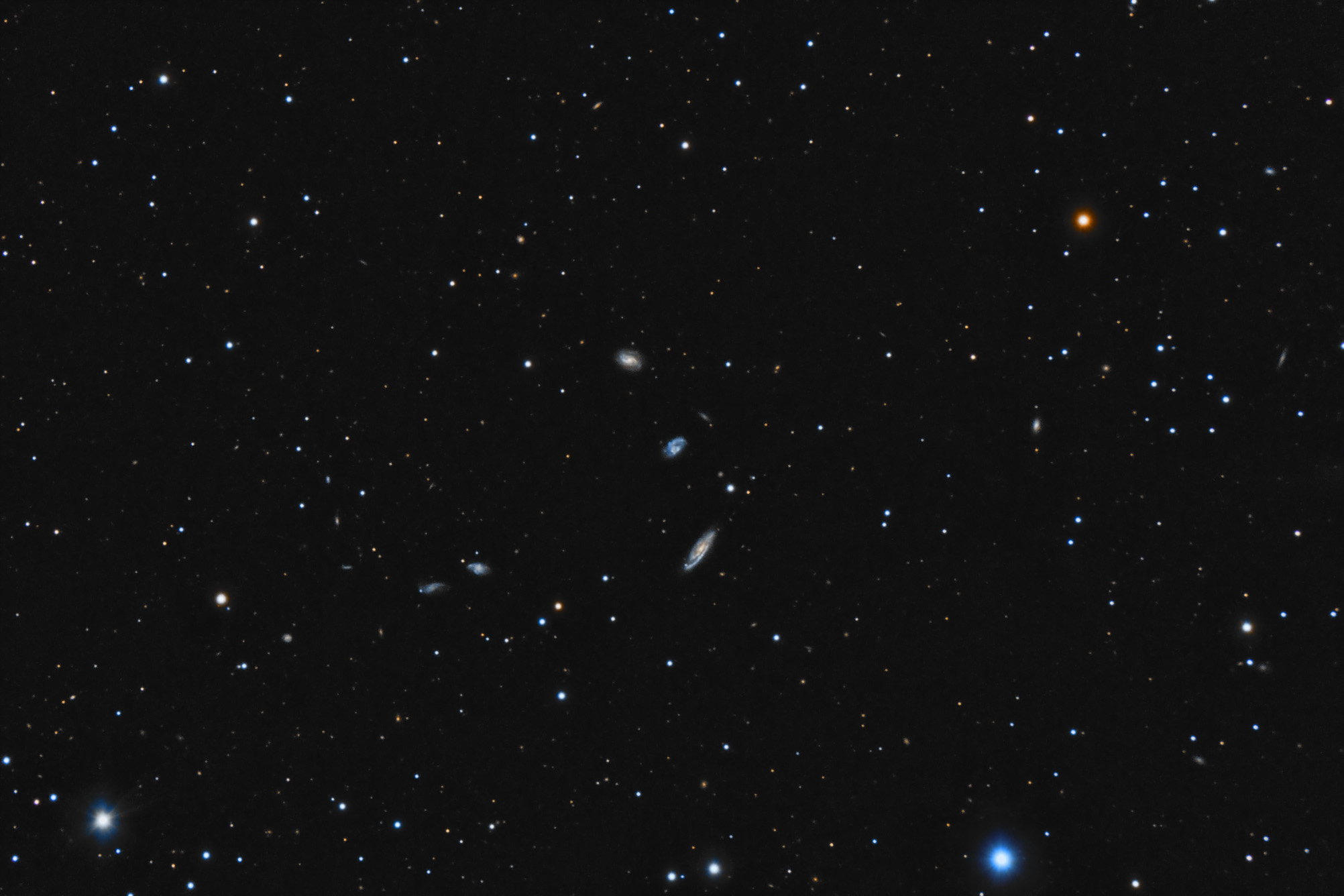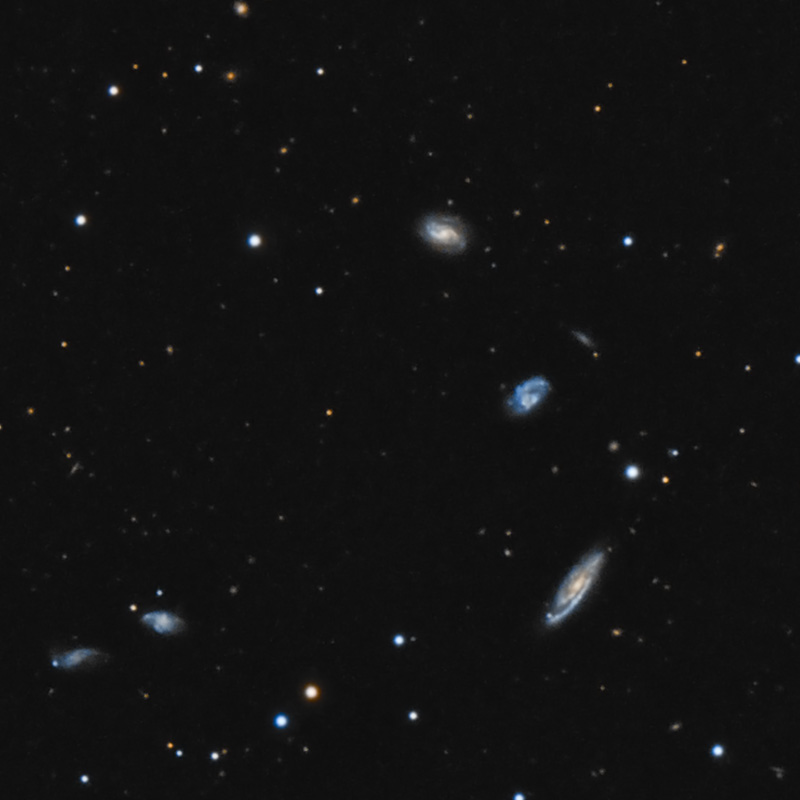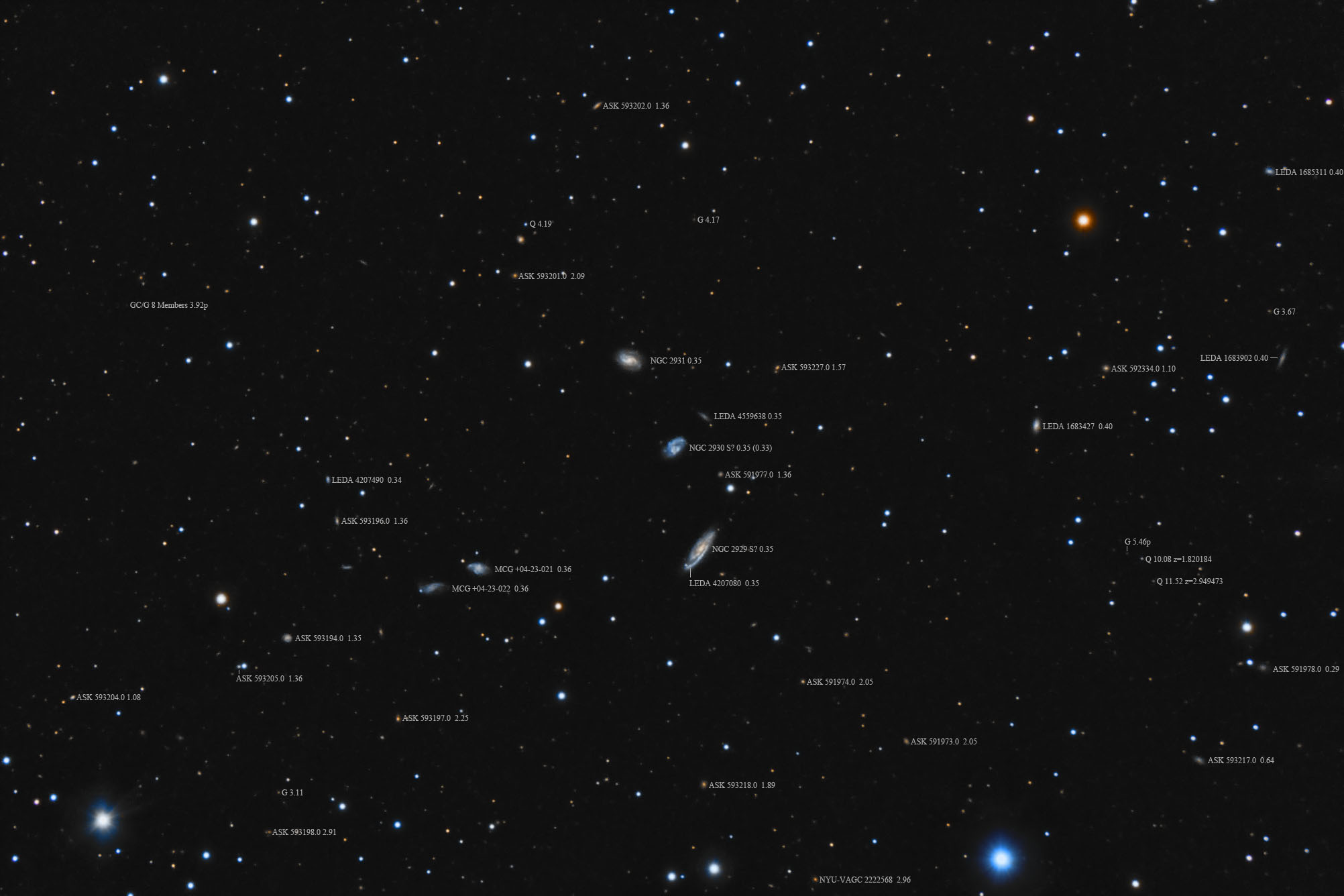Object name: NGC2929Designation(s): NGC2929, NGC2930, NGC2931, WBL 227 is a group of spiral galaxies about 350 million light-years distant in Ursa Major, less than two degrees from the far more famous M51 in Canes Venatici. Officially there are 4 galaxies, NGC 2929, NGC 2930, NGC 2931 and CGCG 122-039. But CGCG 122-039 is two spiral galaxies MCG +04-23-021 and MCG +04-23-22. Here we have a case of 3 plus 1 equals 5.
The three NGC galaxies were all discovered by William Herschel but not on the same night. He tended to leave the scope at a set declination and pick up what the earth's rotation brought into view. Thus he found NGC 2929 and 2230 on November 30, 1834 but didn't sweep up NGC 2231 further north until nearly a month later on December 23, 1834. All are too faint for either H400 list.
NGC 2929 is listed at NED as having a companion on its long drawn out arm that I've marked on the annotated image. It looks like just another knot in the arm to me. I rather doubt it is a real separate galaxy. I've noted it in the annotated image. The odd drawn out arm would fit several of Arp's categories, especially that for spiral galaxies with a heavy arm. NED lists it as S?. I think they mean it is a spiral, they just can't say if it is Sa, Sb, Sc or Sd so leave that letter as a question mark. The NGC Project just says S. While it looks rather small that's due to its distance of 350 million light-years. It really is some 150,000 light-years across.
NGC 2930 is really messed up but has some hint of spiral structure. I'm surprised it isn't listed as Sm. Maybe that is why it too gets a question mark at both NED and the NGC Project. It is some 70,000 light-years in diameter.
NGC 2931 at first glance appears to be a spiral but its arms aren't very "normal" looking to me. NED didn't even try to classify it. However, the NGC Project gives it an S? While it appears larger than 2930 I measure its size as being about the same, 70,000 light years. It's just that it is rounder so covers more area but actually is about the same diameter.
All three NGC galaxies were discovered by Heinrich d'Arrest on February 21, 1863.
The pair of galaxies to the east, CGCG 122-039, appear to be somewhat disorganized spirals as well though I found no one willing to try and classify them. Their redshift puts them slightly further away though I suspect this is more due to their motion in the group than a real distance difference. MCG +04-23-021 is about 65,000 light-years in size while its companion to the east is almost 80,000 light-years across. Its longer drawn out form that makes it appear smaller due to the viewing angle seeing it more edge on.
Since all of them appear disturbed it makes me wonder if they all didn't interact in some way in the past resulting in their motley appearance as we see them some 350 million years ago.
The annotated image shows other galaxies such as LEDA 4207490, 4559638 and maybe 1683427, 1683902 and 1685311 are likely smaller members of the group, though they may form a separate group. Most everything else in the image is well over a billion light-years away.
14" LX200R @ f/10, L=4x10' RGB=2x10', STL-11000XM, Paramount ME Related Designation(s):2MASS J09372984+2309417, 2MASS J09373764+2314268, 2MASX J09372979+2309421, 2MASX J09373771+2314270, 2MASXi J0937297+230941, 2MASXi J0937376+231426, AKARI J0937297+230941, AKARI J0937375+231426, ASK 593192.0, CGCG 0934.6+2323, CGCG 0934.7+2326, CGCG 0934.8+2328, CGCG 122-034, CGCG 122-035, CGCG 122-036, ECO 04790, ECO 04801, ECO 04823, FBQS J093737.6+231426, GALEXASC J093737.71+231427.7 , HDCE 0538 NED002, HDCE 0538 NED003, HOLM 134A, HOLM 134B, HOLM 134C, IRAS 09346+2323, IRAS F09346+2323, IRAS F09346+2326, IRAS F09347+2328, LDCE 0661 NED002, LDCE 0661 NED003, MCG +04-23-017, MCG +04-23-018, MCG +04-23-019, NGC 2929, NGC 2930, NGC 2931, NGC2929, NGC2930, NGC2931, NSA 106565, NSA 135980, NVSS J093729+230941, NVSS J093737+231423, PGC 027398, PGC 027404, PGC 027415, PTF10ygu HOST, SDSS J093729.83+230941.7, SDSS J093729.91+230940.9, SDSS J093737.65+231426.6, SDSS J093737.65+231426.7, SDSS J093737.65+231426.8, UGC 05126, USGC U241 NED01, USGC U241 NED04, USGC U241 NED05, UZC J093729.9+230939, UZC J093732.6+231209, UZC J093737.7+231427, UZC-CG 101 NED01, UZC-CG 101 NED02, WAS 01, WBL 227-001, WBL 227-002, WBL 227-003, [M98j] 068 NED02, [PJY2015] 587741489825316921 , [TTL2012] 442642, [ZBS97] A59-1, [ZBS97] A59-2, [ZBS97] A59-3, | | 

